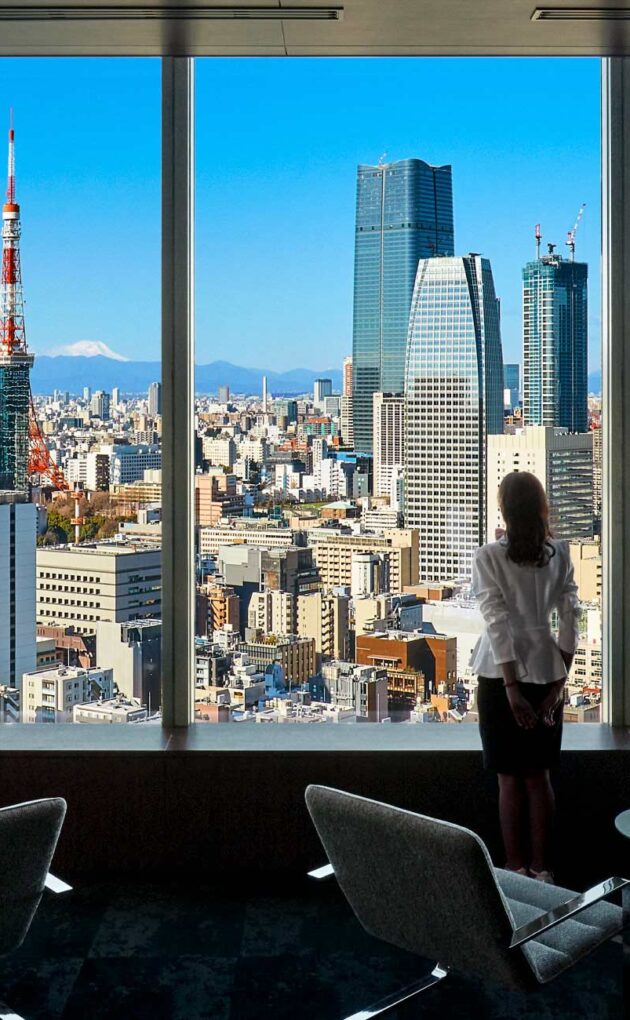Close


In Japan, there’s a saying, “Enjoy the cool breeze”. It means, “by fanning yourself with a cool breeze, you can bear the heat, or cool off”. It’s also used when not speaking about actual body sensations. For example, by hanging a picture of snow in the middle of summer, gazing at an aquarium, looking through something transparent like glass and feeling the ice, or feeling something cool with your eyes and ears, you can take your mind off the heat. This is part of the Japanese people’s wisdom handed down from ancient times, and is a way of enjoying summer.
In this edition of ART colors, we bring the wisdom of our forebears to life, and try to “Enjoy the cool breeze with art”. Here, we mainly feature 6 artists who are on the art scene today: Rieko Fujinami, Junji Yamada、Yumeka Fujita, Aiko Sakamoto, Toru Tohiguchi, and Kanako Watanabe.
The Atrium, laid out around an open space, and giving you a feeling of freedom which you can onlyexperience at the Park Hotel Tokyo, invites you to enjoy the cool breeze with your eyes, and experience the Japanese summer with your ears and taste buds too.
Period: June 2 (Mon.) – August 31 (Sun.), 2014
Hours: 11:30 a.m. – 10:00 p.m.
Location: 25F
Admission: Free
[Cooperated by] Shinobazu Gallery
[Produced by] Creativecreative unit moon
[Video Produced by] antymark
Junji Yamada | Rieko Fujinami | Yumeka Fujita | Aiko Sakamoto | Toru Tohiguchi | Kanako Watanabe
Born 1974, in Nagano Prefecture. Completed his graduate course in oil painting at the Aichi Prefectural University of Fine Arts and Music.
Designed one of the most famous works in the history of art (2D) as a 3D work like a diorama. This 3D work has the same compositional arrangement as the famous painting. It was photographed on printing paper, and etched on printing paper with lines and pearl powder to create a unique artistic effect.
Born 1960, in Chiba prefecture. Graduated from Tama Art University. Currently living in New York.
A modern artist active in Japan and abroad, she uses various techniques driven by motivation, impact and concepts to create photomontages of scenery and people, original frescoes, drawings on clear film, and images.
Born 1976 in Tokyo. Studied screen printing at an art school (under the late Tokuzo Okabe and Hiroshi Matsumura).
Photographs vacation destinations and familiar people, and using screen printing, creates 3D and 2D works by printing the photographs on acrylic resin (used in high performance camera lenses), Japanese paper, and mirrors. There are also works on the theme of light using LED. Often writes poems, incorporating them into part of her works; the titles of some works are actually poems.
Born 1977 in Tokyo. Completed her graduate course at Tama Art University. A Japanese style painter.
She paints invisible things that you can feel, like the wind, sound, air and waves, things that vanish with a slight change of surroundings like sunlight through the trees, or ripples on the water. The butterfly work on exhibit here is one such example. Created from Japanese materials, the bony framework is made of wire, while the wings are traced with an burning incense stick so they look just like real wings.
Born 1975, in Nara Prefecture. Completed his master’s course at Tokyo University of the Arts.
He uses an expressive technique where objects or materials are first decomposed, and then reconstituted by lines. By strictly limiting the amount of information entering the observer’s eye, he excites an inquisitive spirit. By printing silk screens at least 40 to 50 times, he creates a 3D effect with the thickness of the ink. Therefore, when you look at his works close-up, they don’t look like mere lines which you see from afar. Some of his paintings, even the ones that don’t have the 3D effect of a silk screen, give the impression of a neon lamp depending on the colors used.
As part of her doctor’s course at Tama Art University, completed studies in the woodblock printing field in the Art Research Department.
Her technique consists of woodblock printing. She greatly respects the photographer Daido Moriyama; her works involve photographing magazine cut-outs or book inserts, and transferring them to plates. The colors she uses are Japanese ink and whitewash. Printing is done by back-printing. For photoengraving, she uses a cutter knife to engrave notches at various places. She changes the nuance by blurring the ink due to the depth of the notches, and thereby conjures up her own world.